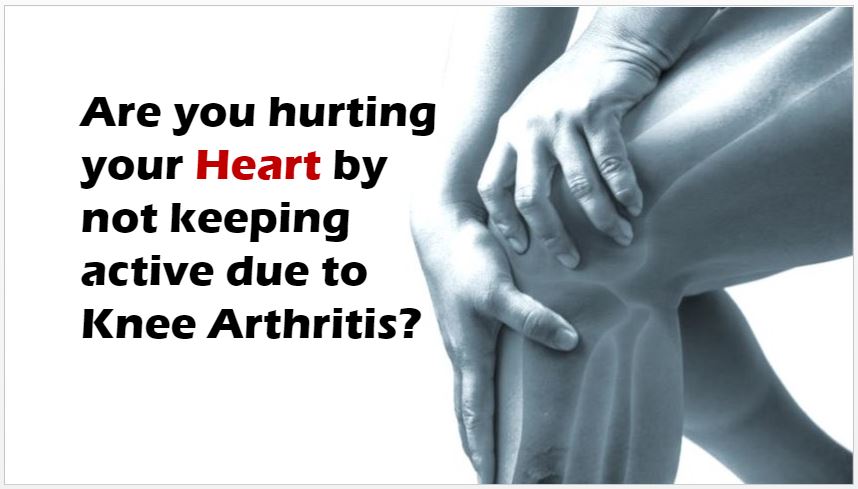Low Activity with Knee Arthritis May Increase the Risk of Heart Disease

How does knee arthritis impact your heart? Many people may believe that the two are distinct issues. However, like anything in the body, one impacts the other.
What Is Osteoarthritis?
Osteoarthritis is a bone and joint disease that occurs as the cartilage and bone that protects the joint begins to degenerate. Cartilage is a smooth, slippery surface that not only absorbs shock but also allows for a nice gliding motion as the joint moves, protecting the bones from bone-on-bone contact. Injuries, toxic substances (such as certain drugs), prior surgeries on the joint, and even wear and tear could be the culprit of cartilage and bone breakdown. As the cartilage degenerates, holes and bone spurs can form as they attempt to correct the joint instability that results.
Joint stiffness and inflammation are associated with arthritis as well as decreased function and activity levels. Osteoarthritis has also been associated with an increased risk of many other health problems, and one of these is heart disease. One study set out to determine why heart disease may develop within a few years of a diagnosis of knee arthritis. Let’s review.
The Link Between Heart Disease and Knee Arthritis? Poor Function and Low Activity
The new study followed patients with knee arthritis who did not initially have cardiovascular disease (CVD). With a known association between arthritis and CVD, the purpose of the study was to investigate the hypothesis that a decrease in function was the key link between the two. At six-plus years, 16% of the knee arthritis patients had developed CVD, and all patients completed three function-based measurements: a health assessment, chair stands, and walking eight feet.
The results? Many of the patients had decreases in at least one functional area; however, the CVD patients had significant decreases in all of the functional measurements. This led researchers to conclude that the association between knee arthritis and CVD was the decrease in function common in arthritis patients.
Does this mean if you are diagnosed with knee arthritis, you just have to live with poor function and the increased risk of heart disease? Not necessarily. Just because you have knee arthritis doesn’t mean you’re condemned to your couch for the rest of your life. It doesn’t mean you should stop being active; in fact, in order to keep proper function in the knee, it’s important to maintain a good exercise routine.
Exercise Is Key to Maintaining Function in an Arthritic Knee
If you have mild to moderate knee arthritis, protecting your remaining knee cartilage—the structure that lives between the bones in the knee and provides a smooth, cushioning surface for movement and protects the bones from contact—is imperative. Exercise has been shown in many studies to not only improve knee arthritis pain and function but more specifically to preserve the remaining cartilage.
Exercise has also been shown to outperform nonsteroidal inflammatory drugs (NSAIDs), such as Advil, Celebrex, and so on, in its effect on arthritis pain, function, and other symptoms. And with the never-ending and constantly growing list of dangers associated with NSAIDs, including the risk that they may actually worsen knee arthritis, relying on them long-term for arthritis relief is just not a good idea.
What kind of exercise is best for knee arthritis? Aerobics? Weight training? Strengthening? It’s probably not surprising that strengthening without bearing weight has been shown to be best for knee arthritis. This would mean, for example, working out on the knee extension machine at the gym without adding weight to it. Aerobics exercise comes in last on this list, and other studies have provided conflicting results on the benefits of running, for example, on knee arthritis with some showing running makes it worse while others show arthritis is no worse in runners than in those who don’t run.
How exactly does exercise improve an arthritic knee? One study found that exercise improves strength and contraction in the muscles around the arthritic knee, stabilizing the knee, and a more stable knee equals a better functioning knee, arthritis or not.
The upshot? Get out there and get active! Your knee may hurt, but sophisticated orthobiologic therapies can help you do more. While many of us likely think that our bum knee isn't impacting anything else, it may be hurting your heart health. So there's another reason to get the pain under control.

If you have questions or comments about this blog post, please email us at [email protected]
NOTE: This blog post provides general information to help the reader better understand regenerative medicine, musculoskeletal health, and related subjects. All content provided in this blog, website, or any linked materials, including text, graphics, images, patient profiles, outcomes, and information, are not intended and should not be considered or used as a substitute for medical advice, diagnosis, or treatment. Please always consult with a professional and certified healthcare provider to discuss if a treatment is right for you.